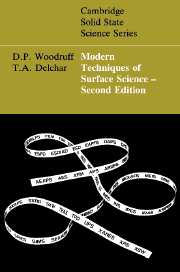Book contents
- Frontmatter
- Contents
- Preface to first edition
- Preface to second edition
- Abbreviations
- 1 Introduction
- 2 Surface crystallography and diffraction
- 3 Electron spectroscopies
- 4 Incident ion techniques
- 5 Desorption spectroscopies
- 6 Tunnelling microscopy
- 7 Work function techniques
- 8 Atomic and molecular beam scattering
- 9 Vibrational spectroscopies
- References
- Index
1 - Introduction
Published online by Cambridge University Press: 26 January 2010
- Frontmatter
- Contents
- Preface to first edition
- Preface to second edition
- Abbreviations
- 1 Introduction
- 2 Surface crystallography and diffraction
- 3 Electron spectroscopies
- 4 Incident ion techniques
- 5 Desorption spectroscopies
- 6 Tunnelling microscopy
- 7 Work function techniques
- 8 Atomic and molecular beam scattering
- 9 Vibrational spectroscopies
- References
- Index
Summary
Why surfaces?
The growth in the study of solid surfaces and in the number of techniques available for their study has been enormous since the early 1960s. At least one reason for this is the growing awareness of the importance of understanding surface properties and indeed the fact that work on surfaces has had an impact on this understanding and on specific applications in the ‘real world’. At a fundamental level surfaces are of great interest because they represent a rather special kind of defect in the solid state. Much of our understanding of solids is based on the fact that they are, in essence, perfectly periodic in three dimensions; the electronic and vibrational properties can be described in great detail using methods which rely on this periodicity. The introduction of a surface breaks this periodicity in one direction and can lead to structural changes as well as the introduction of localised electronic and vibrational states. Gaining a proper understanding of these effects is not only of academic interest, as there is growing interest in the properties of low-dimensional structures in semiconductor devices, and a free surface can represent the simplest case of such a structure.
Perhaps the most widely quoted motivation for modern surface studies is the goal of understanding heterogeneous catalysis.
Information
- Type
- Chapter
- Information
- Modern Techniques of Surface Science , pp. 1 - 14Publisher: Cambridge University PressPrint publication year: 1994
Accessibility standard: Unknown
Why this information is here
This section outlines the accessibility features of this content - including support for screen readers, full keyboard navigation and high-contrast display options. This may not be relevant for you.Accessibility Information
- 1
- Cited by
